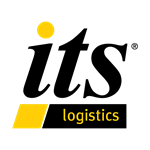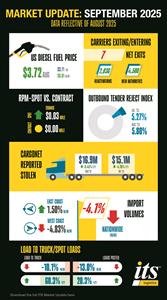ITS Logistics September Supply Chain Report: Industry Witnesses an Increase in Companies Leveraging Tariff Arbitrage Strategy Following the End of De Minimis Exemption
-- ITS Logistics confirms economic uncertainty continues to rise in Q4 with softening of market impacting the drayage, warehouse, and trucking industries --
RENO, Nev., Sept. 26, 2025 (GLOBE NEWSWIRE) -- ITS Logistics released the September ITS Supply Chain Report. This month, the report highlights that, although the U.S. economy showed mixed signals in August, growth and consumer spending remained positive, while inflation stubbornly remained above target. As of now, a recession doesn’t appear imminent, but momentum is clearly slowing, and economic uncertainty continues to rise heading into Q4. This news comes just as industry professionals prepare for the onset of the domestic logistics peak season, further evaluating strategies related to tariff arbitrage, assessing de minimis opportunities, seeking new warehouse locations throughout the U.S., and evaluating the trucking sector's capacity gains.
Containerized imports at the top 10 U.S. ports fell 4.1% month-over-month in August 2025, with sharp declines at key West Coast gateways offset by gains at Seattle, Savannah, and Norfolk. The mixed results reflect both seasonal trends and shifting trade patterns as shippers respond to tariff uncertainty. Import volumes remain above pre-pandemic levels but show heightened sensitivity to policy changes, including the recent repeal of the de minimis exemption on low-value parcels and the upcoming US-China tariff truce expiration.
According to a recent article from Supply Chain Dive, the end of the de minimis exemption has the potential to create new challenges for e-commerce supply chains’ peak season plans. The exemption, which ended on August 29 for imports in the U.S., allowed those valued under $800 to enter the country duty- and tax-free. Eliminated to combat drug trafficking and prevent importers from avoiding tariffs, it was initially expected to end on July 1, 2027, thereby leaving many direct-to-consumer marketplaces scrambling to adjust their peak season strategies. Now that it has been completely eliminated, companies are struggling to adjust their operations ahead of the Q4 holiday shopping rush.
“We’re now seeing ecommerce companies implement a tariff arbitrage strategy in response to the ongoing changes in global trade,” said Josh Allen, chief commercial officer of ITS Logistics. “These companies include everything from the luxury sector on down to those that provide what are considered to be lower-valued goods. This strategy is being leveraged to mitigate shifting tariff impacts and keep overall costs down for their consumers. It is a genius evolution in how companies are adapting to the economic impacts of tariffs and global supply chain management overall.”
As confirmed by CNBC, the business model, formally referred to as business-to-business-to-consumer (B2B2C), is changing the way retailers handle orders placed by consumers on a company’s website. Transactions are being routed to a wholesale platform as the middleman. For the consumer, the process is essentially seamless from purchase to receipt of the merchandise, and for the retailer, the difference in paying tariffs on wholesale prices as opposed to retail prices ranges from 30% to 60%. Despite the clear positives from the newly adopted strategy, some logistics experts are concerned that “tariff hacking” is not a sustainable long-term strategy and will ultimately not be able to keep inflation down.
“Inflation has decreased from peaks but remains above the Fed’s 2% target and rising expectations risk making it more persistent,” continued Allen. “In August, core inflation was 3.1% which signals sticky underlying inflation, remaining above the Federal Reserve’s usual 2% target. The 2.9% headline rate is the highest since January 2025, and the rise above 2.7% and a stronger month-to-month increase (0.4%) suggest inflation picked up pace in August. As a result, consumer confidence in August 2025 showed a slight decline.”
The Organization for Economic Cooperation and Development (OECD) confirmed this week that the full impact of U.S. tariff hikes is still unfolding, but the U.S. and global economies are expected to continue losing momentum in 2026 as higher tariffs take an increasingly large toll on activity. As companies further leverage this newly adopted tariff arbitrage strategy — especially during peak seasons with returns — U.S. warehouses will need to be utilized more by retailers in strategic parts of the U.S. to avoid sending products back from overseas, thereby incurring a new tariff fee.
This month’s index highlights the modest Producer Price Index (PPI) increase in August, indicating a small but notable upward movement in costs or prices within the warehousing and storage industry. This relatively minor change suggests that the sector experienced stability with no significant disruptions occurring between July and August.
Allen added that, “as a result, businesses that rely on warehousing and storage services should anticipate slightly higher costs moving forward, particularly those with contracts that contain variable labor or utility components. As for the trucking sector, spot and contract rates continue to see minimal shifts at the onset of peak season. The ongoing capacity gains since January, combined with easing price growth at the start of peak season, suggest an ongoing softer truckload environment.”
ITS Logistics offers a full suite of network transportation solutions across North America and distribution and fulfillment services to 95% of the U.S. population within two days. These services include drayage and intermodal in 22 coastal ports and 30 rail ramps, a full suite of asset and asset-lite transportation solutions, omnichannel distribution and fulfillment, LTL, and outbound small parcel.
The monthly ITS Supply Chain Report serves to inform ITS employees, partners, and customers of marketplace changes and updates. The information in the report combines data provided through DAT and various industry sources with insights from the ITS team. Visit here for a comprehensive copy of the report with expected industry insights and market updates.
About ITS Logistics
ITS Logistics is one of North America's fastest-growing, asset-based modern 3PLs, providing solutions for the industry’s most complicated supply chain challenges. With a people-first culture committed to excellence, the company relentlessly strives to deliver unmatched value through best-in-class service, expertise, and innovation. The ITS Logistics portfolio features North America's #18 asset-lite freight brokerage, a top drayage and intermodal solution, an asset-based dedicated fleet, an innovative cloud-based technology ecosystem, and a nationwide distribution and fulfillment network.
Media Contact
Amber Good
LeadCoverage
amber@leadcoverage.com
A photo accompanying this announcement is available at https://www.globenewswire.com/NewsRoom/AttachmentNg/235c6491-b8e7-4a4d-b87d-b743e10fe524

Legal Disclaimer:
EIN Presswire provides this news content "as is" without warranty of any kind. We do not accept any responsibility or liability for the accuracy, content, images, videos, licenses, completeness, legality, or reliability of the information contained in this article. If you have any complaints or copyright issues related to this article, kindly contact the author above.


